Ex Post Analysis of Water Supply Demand in an Agricultural Basin by Multi-Source Data Integration
Abstract
1. Introduction
2. Materials and Methods
2.1. Study Site
2.2. Image Acquisition
2.3. Characterization of Agricultural Soil Use via Integration of Sentinel-2 Images and In Situ Information
2.4. Multi-Source Data Integration for Crop Water Demand Estimation
2.4.1. Potential Water Demand
2.4.2. Estimation of Water Use
2.5. Water Availability
3. Results and Discussion
4. Conclusions
Author Contributions
Funding
Institutional Review Board Statement
Informed Consent Statement
Acknowledgments
Conflicts of Interest
References
- Fan, Y.; Massey, R.; Park, S.C. Multi-crop production decisions and economic irrigation water use efficiency: The effects of water costs, pressure irrigation adoption, and climatic determinants. Water 2018, 10, 1637. [Google Scholar] [CrossRef]
- Steduto, P.; Hsiao, T.C.; Fereres, E.; Raes, D. Crop Yield Response to Water; Food and Agriculture Organization of the United Nations: Rome, Italy, 2012; Volume 1028. [Google Scholar]
- Wang, X.-j.; Zhang, J.-y.; Gao, J.; Shahid, S.; Xia, X.-h.; Geng, Z.; Tang, L. The new concept of water resources management in China: Ensuring water security in changing environment. Environ. Dev. Sustain. 2018, 20, 897–909. [Google Scholar] [CrossRef]
- Rivera, D.; Godoy-Faúndez, A.; Lillo, M.; Alvez, A.; Delgado, V.; Gonzalo-Martín, C.; Menasalvas, E.; Costumero, R.; García-Pedrero, Á. Legal disputes as a proxy for regional conflicts over water rights in Chile. J. Hydrol. 2016, 535, 36–45. [Google Scholar] [CrossRef]
- Expósito, A.; Berbel, J. Drivers of irrigation water productivity and basin closure process: Analysis of the Guadalquivir river basin (Spain). Water Resour. Manag. 2019, 33, 1439–1450. [Google Scholar] [CrossRef]
- Molle, F.; Wester, P.; Hirsch, P. River basin closure: Processes, implications and responses. Agric. Water Manag. 2010, 97, 569–577. [Google Scholar] [CrossRef]
- Rosa, L.; Chiarelli, D.D.; Rulli, M.C.; Dell’Angelo, J.; D’Odorico, P. Global agricultural economic water scarcity. Sci. Adv. 2020, 6, eaaz6031. [Google Scholar] [CrossRef]
- Holzapfel, E.; Lillo-Saavedra, M.; Rivera, D.; Gavilán, V.; García-Pedrero, A.; Gonzalo-Martín, C. A satellite-based ex post analysis of water management in a blueberry orchard. Comput. Electron. Agric. 2020, 176, 105635. [Google Scholar] [CrossRef]
- Gavilán, V.; Lillo-Saavedra, M.; Holzapfel, E.; Rivera, D.; García-Pedrero, A. Seasonal Crop Water Balance Using Harmonized Landsat-8 and Sentinel-2 Time Series Data. Water 2019, 11, 2236. [Google Scholar] [CrossRef]
- Khan, M.; Islam, M.; Hafeez, M.; Flugel, W. Decision Support System for an efficient irrigation water management in semi arid environment. AGUFM 2009, 2009, H21A-0828. [Google Scholar]
- Jaiswal, R.K.; Yadav, R.N.; Lohani, A.K.; Tiwari, H.L.; Yadav, S. Water balance modeling of Tandula (India) reservoir catchment using SWAT. Arab. J. Geosci. 2020, 13, 1–13. [Google Scholar] [CrossRef]
- Gonzalo-Martín, C.; Lillo-Saavedra, M.; García-Pedrero, A.; Lagos, O.; Menasalvas, E. Daily Evapotranspiration Mapping Using Regression Random Forest Models. IEEE J. Sel. Top. Appl. Earth Obs. Remote Sens. 2017, 10, 5359–5368. [Google Scholar] [CrossRef]
- Han, J.; Wang, J.; Zhao, Y.; Wang, Q.; Zhang, B.; Li, H.; Zhai, J. Spatio-temporal variation of potential evapotranspiration and climatic drivers in the Jing-Jin-Ji region, North China. Agric. For. Meteorol. 2018, 256–257, 75–83. [Google Scholar] [CrossRef]
- Malik, W.; Dechmi, F. DSSAT modelling for best irrigation management practices assessment under Mediterranean conditions. Agric. Water Manag. 2019, 216, 27–43. [Google Scholar] [CrossRef]
- Trentacoste, E.R.; Puertas, C.M.; Sadras, V.O. Effect of irrigation and tree density on vegetative growth, oil yield and water use efficiency in young olive orchard under arid conditions in Mendoza, Argentina. Irrig. Sci. 2015, 33, 429–440. [Google Scholar] [CrossRef]
- Kolokytha, E.; Malamataris, D. Integrated Water Management Approach for Adaptation to Climate Change in Highly Water Stressed Basins. Water Resour. Manag. 2020, 34, 1173–1197. [Google Scholar] [CrossRef]
- Tadese, M.; Kumar, L.; Koech, R.; Kogo, B.K. Mapping of land-use/land-cover changes and its dynamics in Awash River Basin using remote sensing and GIS. Remote Sens. Appl. Soc. Environ. 2020, 19, 100352. [Google Scholar] [CrossRef]
- ESA. Detailed Description of the Sen2-Agri System, European Space Agency (ESA). 2019. Available online: http://www.esa-sen2agri.org/operational-system/system-description/ (accessed on 1 December 2020).
- Inglada, J.; Arias, M.; Tardy, B.; Hagolle, O.; Valero, S.; Morin, D.; Dedieu, G.; Sepulcre, G.; Bontemps, S.; Defourny, P.; et al. Assessment of an operational system for crop type map production using high temporal and spatial resolution satellite optical imagery. Remote Sens. 2015, 7, 12356–12379. [Google Scholar] [CrossRef]
- Defourny, P.; Bontemps, S.; Bellemans, N.; Cara, C.; Dedieu, G.; Guzzonato, E.; Hagolle, O.; Inglada, J.; Nicola, L.; Rabaute, T.; et al. Near real-time agriculture monitoring at national scale at parcel resolution: Performance assessment of the Sen2-Agri automated system in various cropping systems around the world. Remote Sens. Environ. 2019, 221, 551–568. [Google Scholar] [CrossRef]
- Kussul, N.; Shelestov, A.; Lavreniuk, M.; Kolotii, A.; Vasiliev, V. Land Cover and Land Use Monitoring Based on Satellite Data within World Bank Project. In Proceedings of the 2019 10th International Conference on Dependable Systems, Services and Technologies (DESSERT), Leeds, UK, 5–7 June 2019; pp. 127–130. [Google Scholar]
- Moumni, A.; Sebbar, B.e.; Simonneaux, V.; Ezzahar, J.; Lahrouni, A. Evaluation Of Sen2agri System Over Semi-Arid Conditions: A Case Study Of The Haouz Plain In Central Morocco. In Proceedings of the 2020 Mediterranean and Middle-East Geoscience and Remote Sensing Symposium (M2GARSS), Tunis, Tunisia, 9–11 March 2020; pp. 343–346. [Google Scholar]
- Vijayasekaran, D. SEN2-AGRI–Crop Type Mapping Pilot Study Using Sentinel-2 Satellite Imagery in India. Int. Arch. Photogramm. Remote Sens. Spat. Inf. Sci. 2019. [Google Scholar] [CrossRef]
- Valdés-Pineda, R.; Pizarro, R.; García-Chevesich, P.; Valdés, J.B.; Olivares, C.; Vera, M.; Balocchi, F.; Pérez, F.; Vallejos, C.; Fuentes, R.; et al. Water governance in Chile: Availability, management and climate change. J. Hydrol. 2014, 519, 2538–2567. [Google Scholar] [CrossRef]
- Garreaud, R.D.; Alvarez-Garreton, C.; Barichivich, J.; Boisier, J.P.; Christie, D.; Galleguillos, M.; LeQuesne, C.; McPhee, J.; Zambrano-Bigiarini, M. The 2010–2015 megadrought in central Chile: Impacts on regional hydroclimate and vegetation. Hydrol. Earth Syst. Sci. 2017, 21, 6307–6327. [Google Scholar] [CrossRef]
- Brooks, D.B. An operational definition of water demand management. Int. J. Water Resour. Dev. 2006, 22, 521–528. [Google Scholar] [CrossRef]
- CR2. Explorador Climático, Center for Climate and Resilience Research. 2020. Available online: http://explorador.cr2.cl/ (accessed on 30 March 2021).
- Aitken, D.; Rivera, D.; Godoy-Faúndez, A.; Holzapfel, E. Water scarcity and the impact of the mining and agricultural sectors in Chile. Sustainability 2016, 8, 128. [Google Scholar] [CrossRef]
- DCM. Servicios Climáticos, Dirección Meteorológica de Chile (DMC). 2020. Available online: https://climatologia.meteochile.gob.cl/ (accessed on 30 March 2021).
- JVRL. Junta de Vigilancia Río Longaví y sus Afluentes. 2020. Available online: https://www.juntariolongavi.cl/ (accessed on 1 April 2021).
- Bontemps, S.; Arias, M.; Cara, C.; Dedieu, G.; Guzzonato, E.; Hagolle, O.; Inglada, J.; Matton, N.; Morin, D.; Popescu, R.; et al. Building a data set over 12 globally distributed sites to support the development of agriculture monitoring applications with Sentinel-2. Remote Sens. 2015, 7, 16062–16090. [Google Scholar] [CrossRef]
- Weiss, M.; Baret, F.; Leroy, M.; Hautecœur, O.; Bacour, C.; Prevol, L.; Bruguier, N. Validation of neural net techniques to estimate canopy biophysical variables from remote sensing data. Agron.-Scie. Prod. Veg. Environ. 2002, 22, 547–554. [Google Scholar] [CrossRef]
- INE. Geodatos Abiertos, Instituto Nacional de Estadística (INE). 2020. Available online: https://www.ine.cl/herramientas/portal-de-mapas/geodatos-abiertos (accessed on 31 March 2020).
- Büttner, G.; Feranec, J.; Jaffrain, G.; Mari, L.; Maucha, G.; Soukup, T. The CORINE land cover 2000 project. EARSeL eProceedings 2004, 3, 331–346. [Google Scholar]
- Congalton, R.G. A review of assessing the accuracy of classifications of remotely sensed data. Remote Sens. Environ. 1991, 37, 35–46. [Google Scholar] [CrossRef]
- Feret, J.B.; François, C.; Asner, G.P.; Gitelson, A.A.; Martin, R.E.; Bidel, L.P.; Ustin, S.L.; Le Maire, G.; Jacquemoud, S. PROSPECT-4 and 5: Advances in the leaf optical properties model separating photosynthetic pigments. Remote Sens. Environ. 2008, 112, 3030–3043. [Google Scholar] [CrossRef]
- RAN. Agromet, Red Agroclimática Nacional (RAN). 2020. Available online: https://www.agromet.cl/ (accessed on 20 November 2020).
- Pereira, A.R.; de Camargo, M.B.P.; Nova, N.A.V. Coeficiente de cultivo de cafezais com base no índice de área foliar para irrigação de precisão. Bragantia 2011, 70, 946–951. [Google Scholar] [CrossRef]
- Bastiaanssen, W.G.; Menenti, M.; Feddes, R.A.; Holtslag, A.A. A remote sensing surface energy balance algorithm for land (SEBAL): 1. Formulation. J. Hydrol. 1998, 212–213, 198–212. [Google Scholar] [CrossRef]
- Allen, R.G.; Tasumi, M.; Trezza, R. Satellite-Based Energy Balance for Mapping Evapotranspiration with Internalized Calibration (METRIC)—Model. J. Irrig. Drain. Eng. 2007, 133, 380–394. [Google Scholar] [CrossRef]
- Fonseca-Luengo, D.; Lillo-Saavedra, M.; Lagos, L.O.; García-Pedrero, A.; Gonzalo-Martín, C. Use of Machine Learning to Improve the Robustness of Spatial Estimation of Evapotranspiration; Lecture Notes in Computer Science (including Subseries Lecture Notes in Artificial Intelligence and Lecture Notes in Bioinformatics); Springer: Berlin, Germany, 2017; Volume 10657 LNCS, pp. 237–245. [Google Scholar]
- DGA. Derechos de Aprovechamiento de Aguas Registrados en la Dirección General de Aguas de Chile (DGA). 2020. Available online: https://dga.mop.gob.cl/productosyservicios/derechos_historicos/Paginas/default.aspx (accessed on 10 June 2020).
- IDE Chile. Cuencas Banco Nacional de Aguas de Chile, Infraestrucutra de Datos Geoespaciales (IDE). 2020. Available online: https://www.ide.cl/index.php/medio-ambiente/item/1635-cuencas-banco-nacional-de-aguas (accessed on 3 April 2021).
- Kuschel-Otárola, M.; Rivera, D.; Holzapfel, E.; Palma, C.D.; Godoy-Faúndez, A. Multiperiod optimisation of irrigated crops under different conditions of water availability. Water 2018, 10, 1434. [Google Scholar] [CrossRef]
- Kuschel-Otárola, M.; Rivera, D.; Holzapfel, E.; Schütze, N.; Neumann, P.; Godoy-Faúndez, A. Simulation of Water-Use Efficiency of Crops under Different Irrigation Strategies. Water 2020, 12, 2930. [Google Scholar] [CrossRef]
- Kuschel-Otárola, M.; Schütze, N.; Holzapfel, E.; Godoy-Faúndez, A.; Mialyk, O.; Rivera, D. Estimation of yield response factor for each growth stage under local conditions using AquaCrop-OS. Water 2020, 12, 1080. [Google Scholar] [CrossRef]
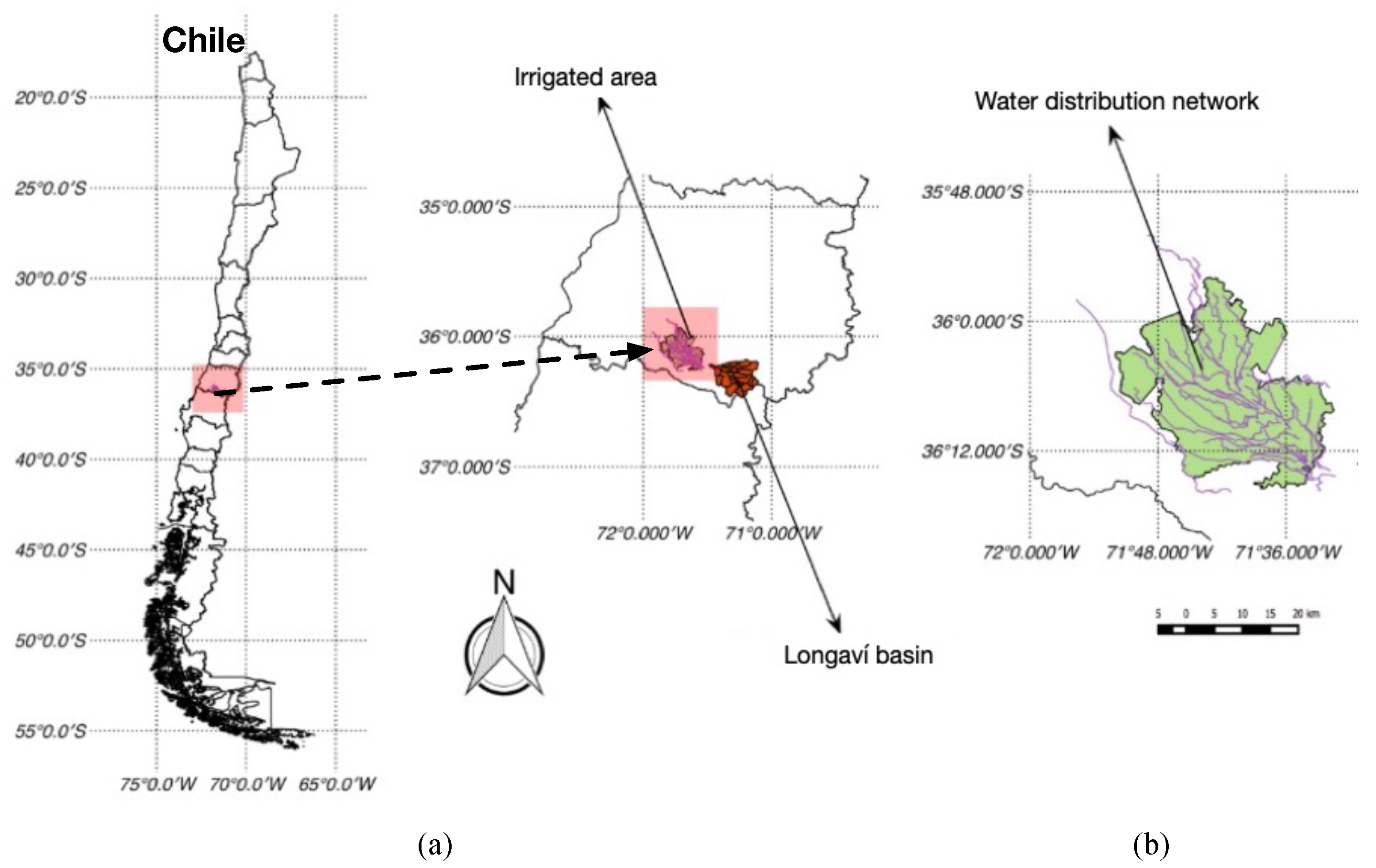
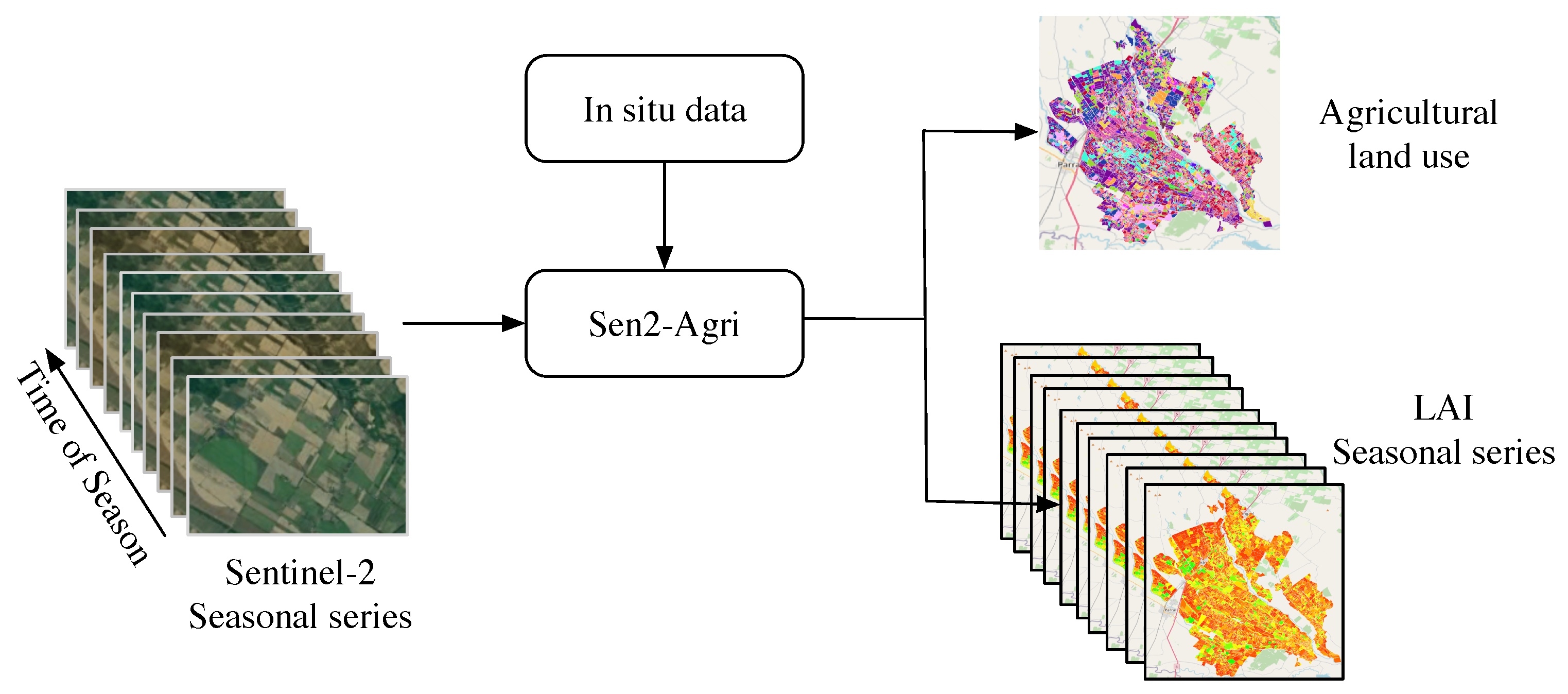
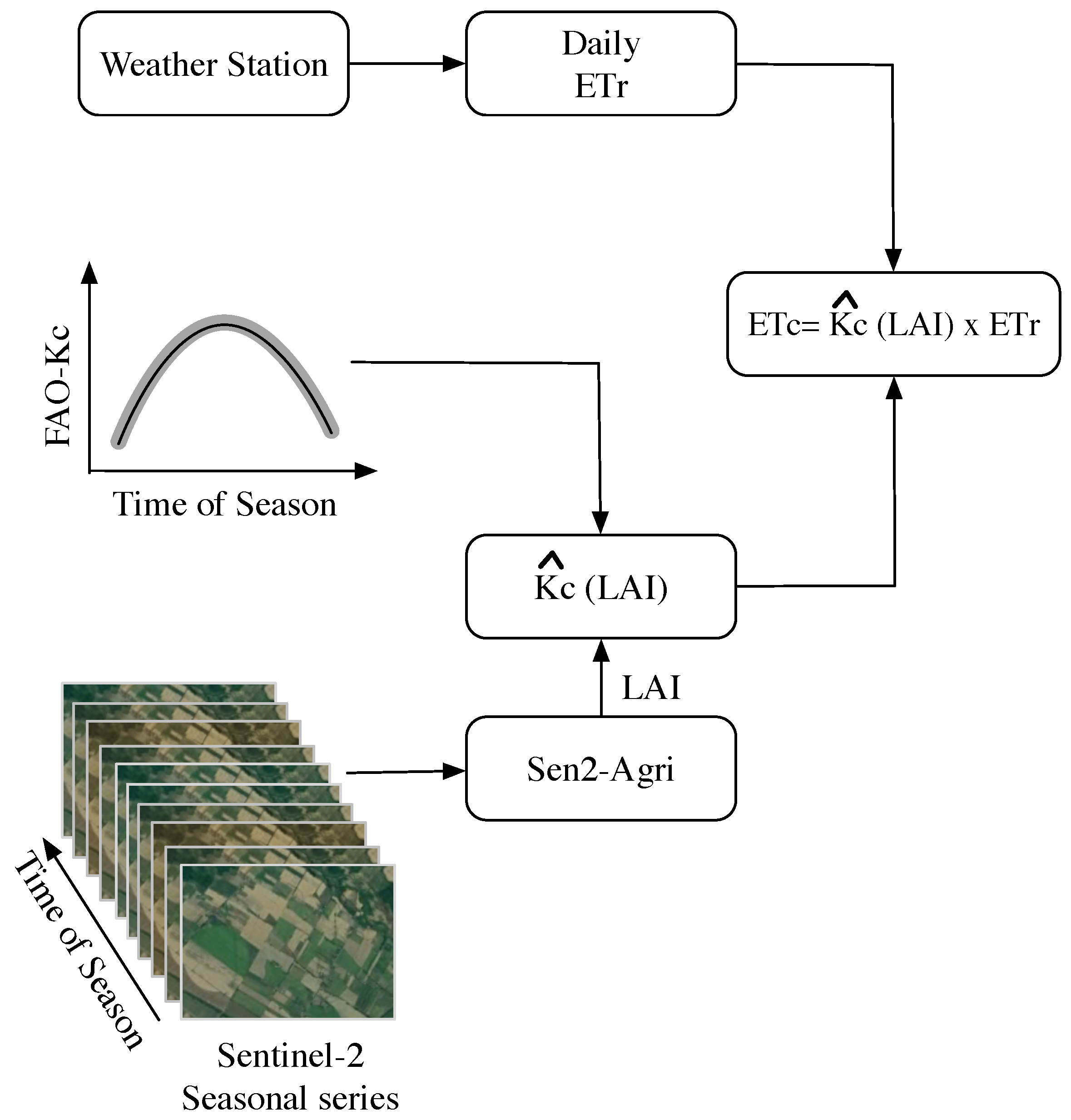
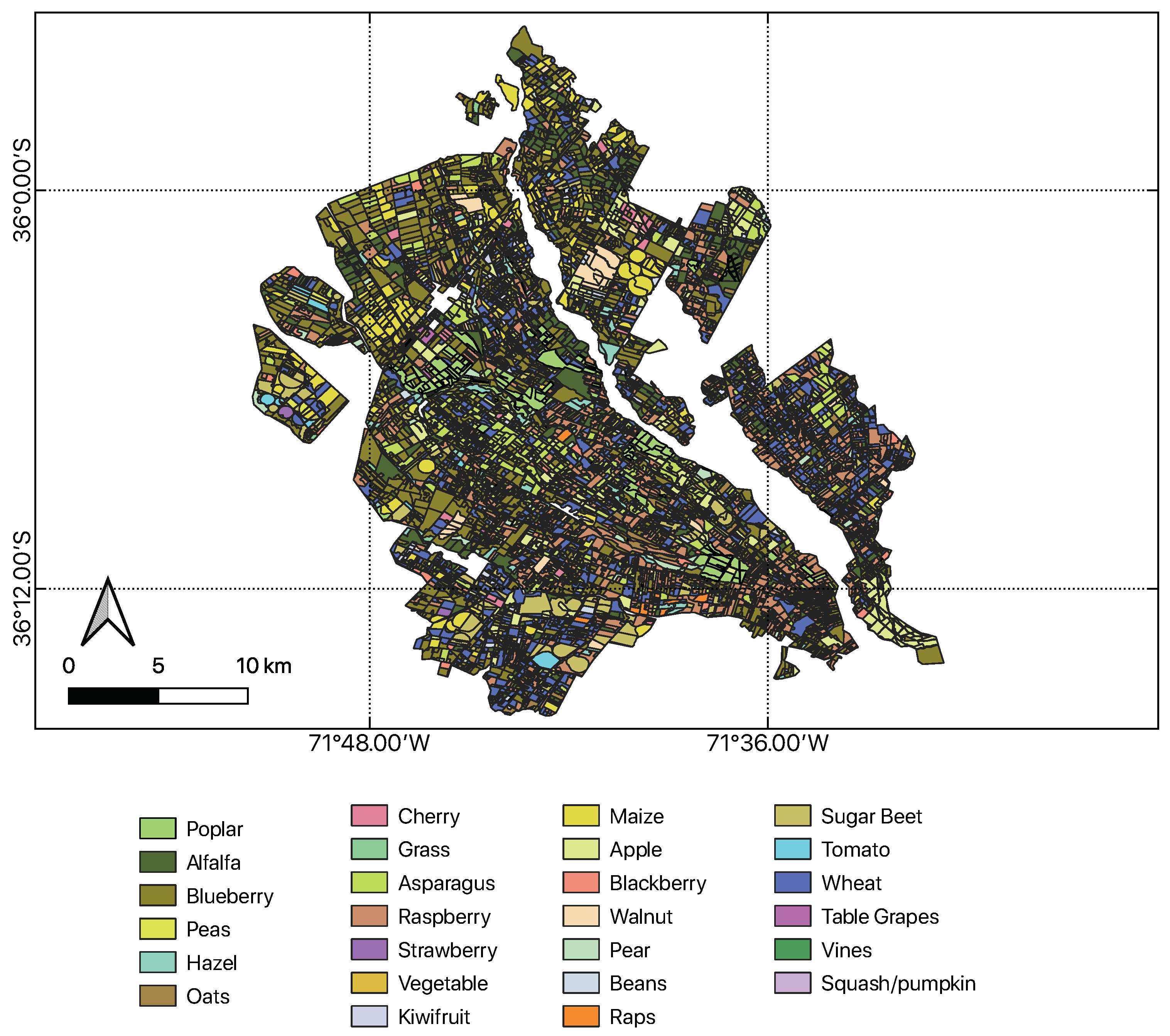
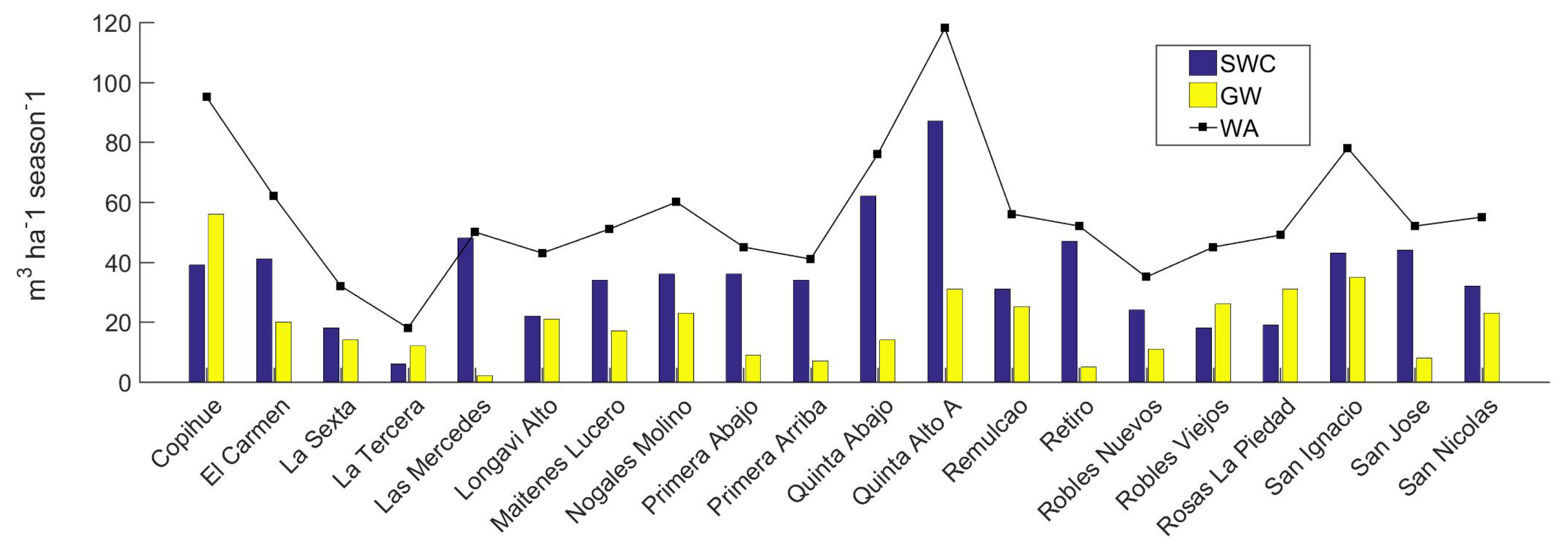

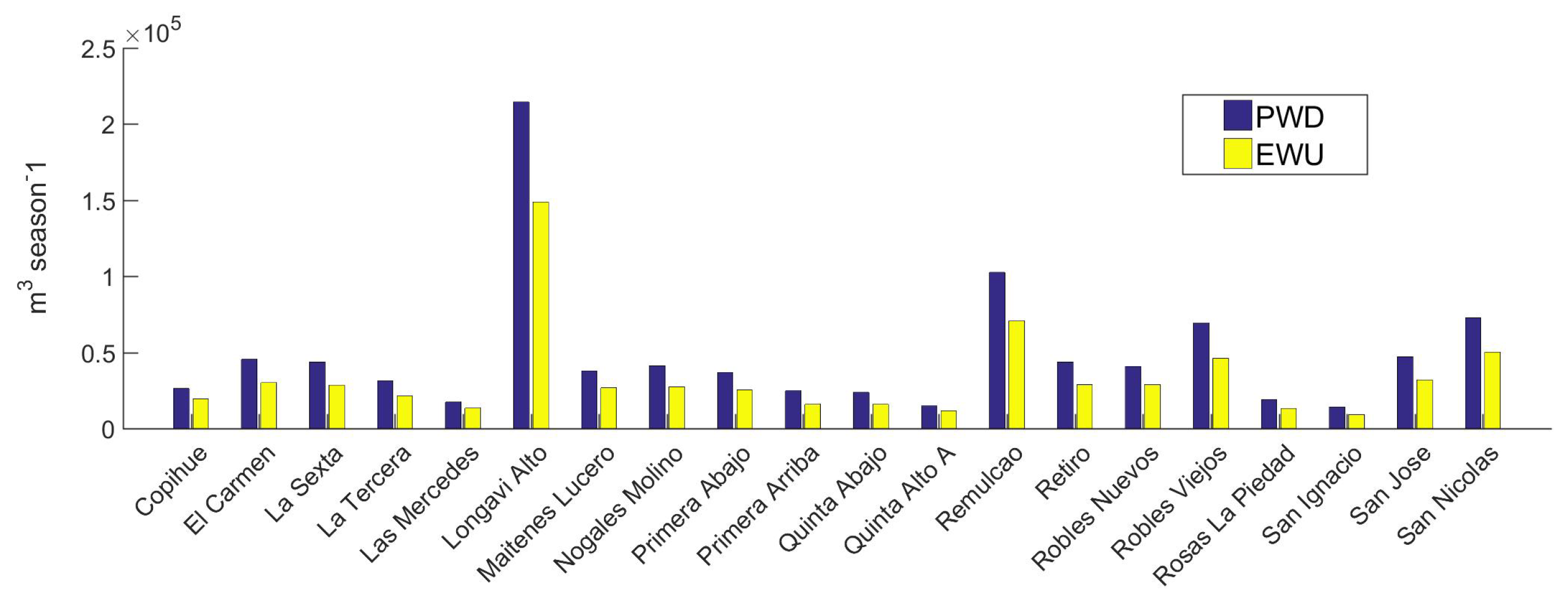
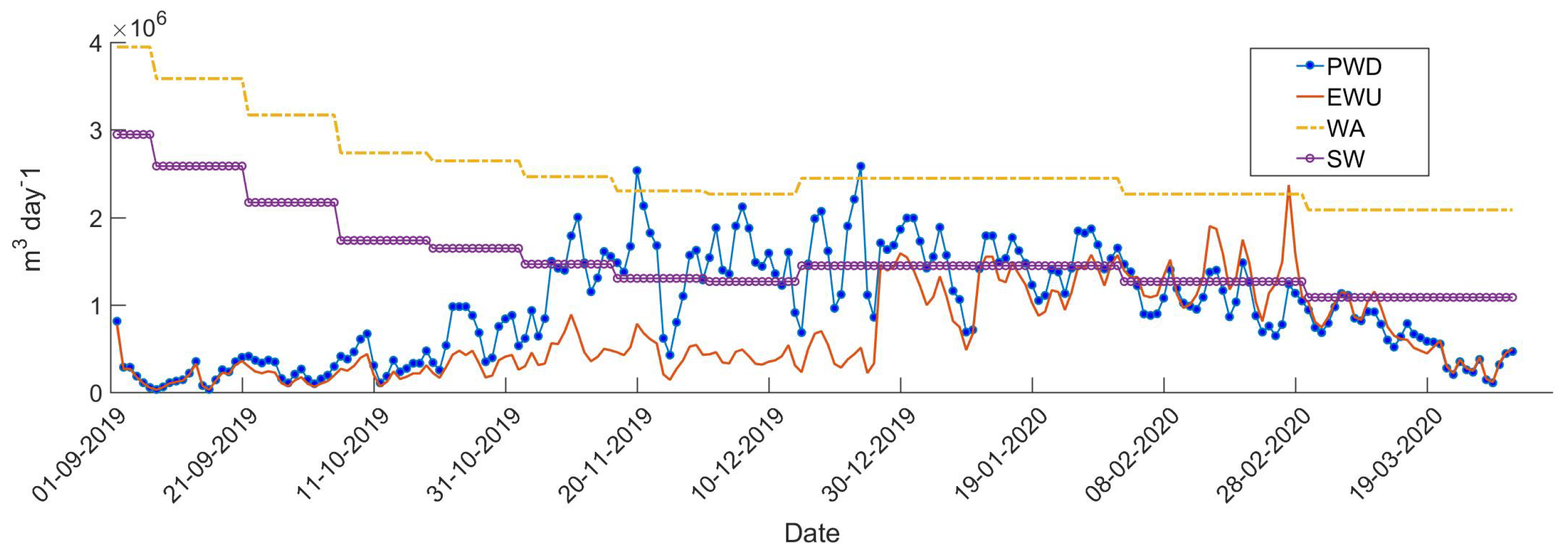
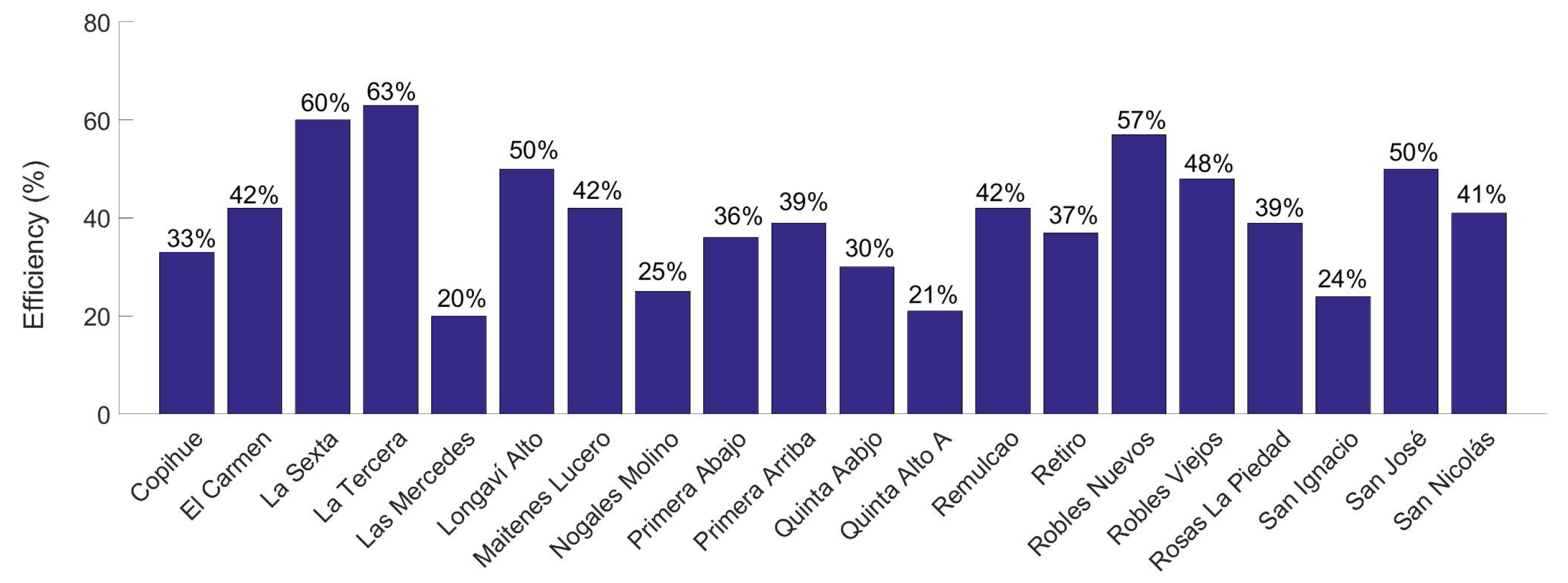
| Landsat-8 () | Sentinel-2 () | ||||||
|---|---|---|---|---|---|---|---|
| Date | DOY | Date | DOY | Date | DOY | Date | DOY |
| 20 September 2019 | 263 | 16 September 2020 | 259 | 25 December 2020 | 359 | 23 February 2020 | 54 |
| 22 October 2019 | 295 | 21 September 2020 | 264 | 30 December 2020 | 364 | 28 February 2020 | 59 |
| 7 November 2019 | 311 | 21 October 2020 | 294 | 9 January 2020 | 9 | 4 March 2020 | 64 |
| 25 December 2019 | 359 | 5 November 2020 | 309 | 14 January 2020 | 14 | 9 March 2020 | 69 |
| 10 January 2020 | 10 | 10 November 2020 | 314 | 24 January 2020 | 24 | 14 March 2020 | 74 |
| 26 January 2020 | 26 | 20 November 2020 | 324 | 29 January 2020 | 29 | 19 March 2020 | 79 |
| 11 February 2020 | 42 | 30 November 2020 | 334 | 3 February 2020 | 34 | ||
| 27 February 2020 | 58 | 5 December 2020 | 339 | 8 February 2020 | 39 | ||
| 14 March 2020 | 74 | 10 December 2020 | 344 | 13 February 2020 | 44 | ||
| 30 March 2020 | 90 | 20 December 2020 | 354 | 18 February 2020 | 49 | ||
| Name of Main Canal | Irrigated Surface (ha) | Surface Water Rights () (m3/min) |
|---|---|---|
| Copihue | 1704 | 54.0 |
| El Carmen | 1855 | 61.9 |
| La Sexta | 1898 | 27.7 |
| La Tercera | 2113 | 9.5 |
| Las Mercedes | 1561 | 60.8 |
| Longavi Alto | 9548 | 174.2 |
| Maitenes Lucero Cunao | 1914 | 52.2 |
| Nogales Molino | 3344 | 98.8 |
| Primera Abajo | 2195 | 63.7 |
| Primera Arriba | 1344 | 37.3 |
| Quinta Abajo | 973 | 49.0 |
| Quinta Alto A | 739 | 52.4 |
| Retiro | 1865 | 71.5 |
| Robles Nuevos | 1822 | 35.3 |
| Robles Viejos | 3220 | 48.4 |
| Rosas La Piedad | 1188 | 18.0 |
| San Ignacio | 1031 | 36.0 |
| San José | 1546 | 55.7 |
| San Nicolás | 4142 | 106.7 |
| Remulcao | 5590 | 141.9 |
| Total | 49,591 | 1255.0 |
Publisher’s Note: MDPI stays neutral with regard to jurisdictional claims in published maps and institutional affiliations. |
© 2021 by the authors. Licensee MDPI, Basel, Switzerland. This article is an open access article distributed under the terms and conditions of the Creative Commons Attribution (CC BY) license (https://creativecommons.org/licenses/by/4.0/).
Share and Cite
Lillo-Saavedra, M.; Gavilán, V.; García-Pedrero, A.; Gonzalo-Martín, C.; de la Hoz, F.; Somos-Valenzuela, M.; Rivera, D. Ex Post Analysis of Water Supply Demand in an Agricultural Basin by Multi-Source Data Integration. Remote Sens. 2021, 13, 2022. https://doi.org/10.3390/rs13112022
Lillo-Saavedra M, Gavilán V, García-Pedrero A, Gonzalo-Martín C, de la Hoz F, Somos-Valenzuela M, Rivera D. Ex Post Analysis of Water Supply Demand in an Agricultural Basin by Multi-Source Data Integration. Remote Sensing. 2021; 13(11):2022. https://doi.org/10.3390/rs13112022
Chicago/Turabian StyleLillo-Saavedra, Mario, Viviana Gavilán, Angel García-Pedrero, Consuelo Gonzalo-Martín, Felipe de la Hoz, Marcelo Somos-Valenzuela, and Diego Rivera. 2021. "Ex Post Analysis of Water Supply Demand in an Agricultural Basin by Multi-Source Data Integration" Remote Sensing 13, no. 11: 2022. https://doi.org/10.3390/rs13112022
APA StyleLillo-Saavedra, M., Gavilán, V., García-Pedrero, A., Gonzalo-Martín, C., de la Hoz, F., Somos-Valenzuela, M., & Rivera, D. (2021). Ex Post Analysis of Water Supply Demand in an Agricultural Basin by Multi-Source Data Integration. Remote Sensing, 13(11), 2022. https://doi.org/10.3390/rs13112022











